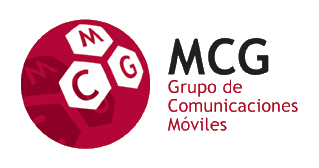The Mobile Communications Group (MCG) is composed of about 30 people between professors and researchers whose are currently involved in different research projects, which are divided in three main research areas: Wireless In-body Devices, Broadcast Technologies and Wireless Technologies.
In the framework of Wireless In-body Devices, led by Prof. Cardona, the MCG has been working towards three different fields. Firstly, accurate characterization of the UWB in-body propagation channel which implies the design of novel in-body antennas taking into account the particular characteristics of the surrounding environment. Secondly, the development of tissue characterization tools that allow either measure biological tissues in wideband as well as the characterization of chemical compounds for laboratory use. And thirdly, the investigation of new phantom formulas for the emulation of different body tissues in wideband that can be used for testing wireless communications signals and algorithms. In this research field, the MCG is part of the H2020 Innovative Training Network (ITN) WIBEC (Wireless In-Body Environment Communications), which is focused in the field of wireless implantable communications. The main project is WIBEC, an ITN network of the MSCA-H2020 European programme, focused on the training of PhDs in this field.
Moreover, the MCG has extensive knowledge in the area of Broadcast Technologies, which is led by Dr. Gómez-Barquero. In this field, the MCG has wide experience in multimedia broadcasting in general, an in particular in the optimization of DVB (Digital Video Broadcasting), ATSC (Advanced Television Systems Committee) and 3GPP MBMS (Multimedia Broadcast Multicast Service) systems. Within this area, the MCG has been actively contributing to the standardization of the DVB-T2, DVB-NGH and ATSC 3.0 standards and has established fruitful collaborations with leading companies in the broadcasting industry. Moreover, the group has participated in the design and network planning of the DVB-T2 network in Colombia and has evaluated the spectrum compatibility between 4G cellular technologies and analog and digital TV broadcast systems. In its facility, the MCG has a laboratory full of DVB operating end-to-end and a pilot network DVB-T / H on the campus of the UPV. The MCG also owns a DVB-T/H/SH/T2 measurement system which has been successfully tested in several pilot and actively participates in the forum DVB standardization. Currently, the flagship project of this area is the 5G-Xcast whose main objective is to design the point-to-point multicast and broadcast components of the 5G.
Finally, the MCG has an important activity in the area of Wireless Technology, led by Dr. Monserrat, which highlights in fields like planning and optimization of UMTS, HSDPA and LTE, management and radio resource optimization in 3GPP networks, and cognitive radio systems transmission techniques for the next generation DVB fixed and mobile systems. In this framework, the MCG focuses its researches in two different fields. Firstly, there is a clear research line devoted to the new generation of mobile and wireless communications, known as 5G. This area focuses on radio aspects for future communication networks. Secondly, the group is working on vehicular communications with the aim of guaranteeing the optimum operation of each vehicle communication equipment and its interconnection in a 5G technology use scenario, and thereby contribute to reduce the number of traffic crashes and to increase the levels of road safety. In this field, the MCG was part of the METIS (Mobile and wireless communications Enablers for the Twenty-twenty Information Society) FP7 IP project, and METIS II, H2020 project. The main objective of these projects is lay the foundation of 5G, the next generation mobile and wireless communications system. Currently the MCG has received European funding as part of the European project 5G-CARMEN oriented to vehicular communications.
The MCG publishes an average of 16 papers per year, being the greatest contributions to journals like IEEE Networks, IEEE Communications Magazine, IEEE Transactions on Communications, IEEE Transaction on Vehicular Technology, IEEE Communication Letters, IEE Electronics Letters, IEEE Transactions on broadcasting and EURASIP Journal on Wireless Communications and Networking.
In the field of technology transfer, the Mobile Communications Group has collaborated with Spanish and international companies of the telecommunications industry as SistelBanda, Ingenia Telecom (an Astellia company), NGARO Intelligent Solutions S.L., BMW Munich, Abertis, LG electronics, Vodafone, Axión, Egatel, Sapec, TesAmérica, Hispasat, RAI Italia, etc. This transfer of technology has been carried out in many different ways, from little technical studies to very important agreements, and being part of R&D projects funded by Spanish and European institutions.
The activity of the MCG is focused on the following lines:
- Planning and optimization tools for mobile communications systems: UMTS, HSDPA, LTE
- UMTS software solutions development
- Radio channel modelling
- Cellular Networks Planning, Tuning and (Self-)Optimization
- Common Radio Resource Management Techniques
- Radio Resource Management and Optimization in 3GPP networks
- Cognitive Radio Systems
- Cooperative Multipoint, Relaying and Interference Coordination
- Broadcast Systems evolution: DVB-T2, -SH, -NGH
- MBMS & Hybrid Cellular-Broadcasting Systems
- Transmission techniques for next generation fixed and mobile DVB systems
- Mobile Applications, RAN Engineering and Drive-Test tools
- Multimedia Independent Handover
- LTE Femtocells implementation
- Body Area Networks
- Electromagnetic Characterization Body Tissues

